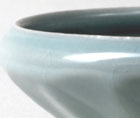J.J. Lally & Co., Oriental Art / New York City, New York
MenuPast Exhibition
Chinese Ceramics A.D. 400–1400:
Selections from an American Collection
March 19 - 31, 2007
20.
A LONGQUAN CELADON LOTUS PETAL BOWL (LIAN KOU WAN)
Southern Song Dynasty (A.D. 1127-1279)
of well potted deep circular form, the flared sides carved on the exterior with slender lotus petals rising from a small ring foot to the underside of the incurved rim with thin upturned lip, covered inside and out with a bluish-green glaze continuing over the flat recessed base, the knife-pared edge of the foot covered before firing with a dark purplish-brown dressing.
Diameter 5 1⁄2 inches (14 cm)
A celadon bowl of this distinctive form excavated in 1960 at Longquan, Zhejiang province is illustrated in the catalogue of The Genius of China: An Exhibition of Archaeological Finds of the People’s Republic of China, London, 1973, no. 334. The same bowl is illustrated by Zhu, Longquan Yao Qingci (Celadons from Longquan Kilns), Taipei, 1998, no. 134, p. 163 and was recently exhibited in Geneva at the Musée des Collections Baur and in Paris at the Musée Cernuschi, illustrated in the catalogue entitled Céladon: Gres des musées de la province du Zhejiang, Chine, Paris, 2005, no. 77, p. 177.
The usual shape of this bowl may be based on a Seljuq metal prototype. A larger Longquan celadon bowl of similar form is illustrated by Medley, Metalwork and Chinese Ceramics, London, 1972, pl. 15b, together with a Seljuq Persian bronze bowl of similar form in the Victoria and Albert Museum, pl. 15a. Sherds from larger Longquan celadon bowls of this type excavated at Fostat, Egypt are published by Gyllensvärd, “Recent Finds of Chinese Ceramics at Fostat II,” Bulletin of the Museum of Far Eastern Antiquities, Stockholm, No. 47, 1975, pl. 14, together with a similar Longquan bowl from the Collection of the National Palace Museum, Taiwan.
